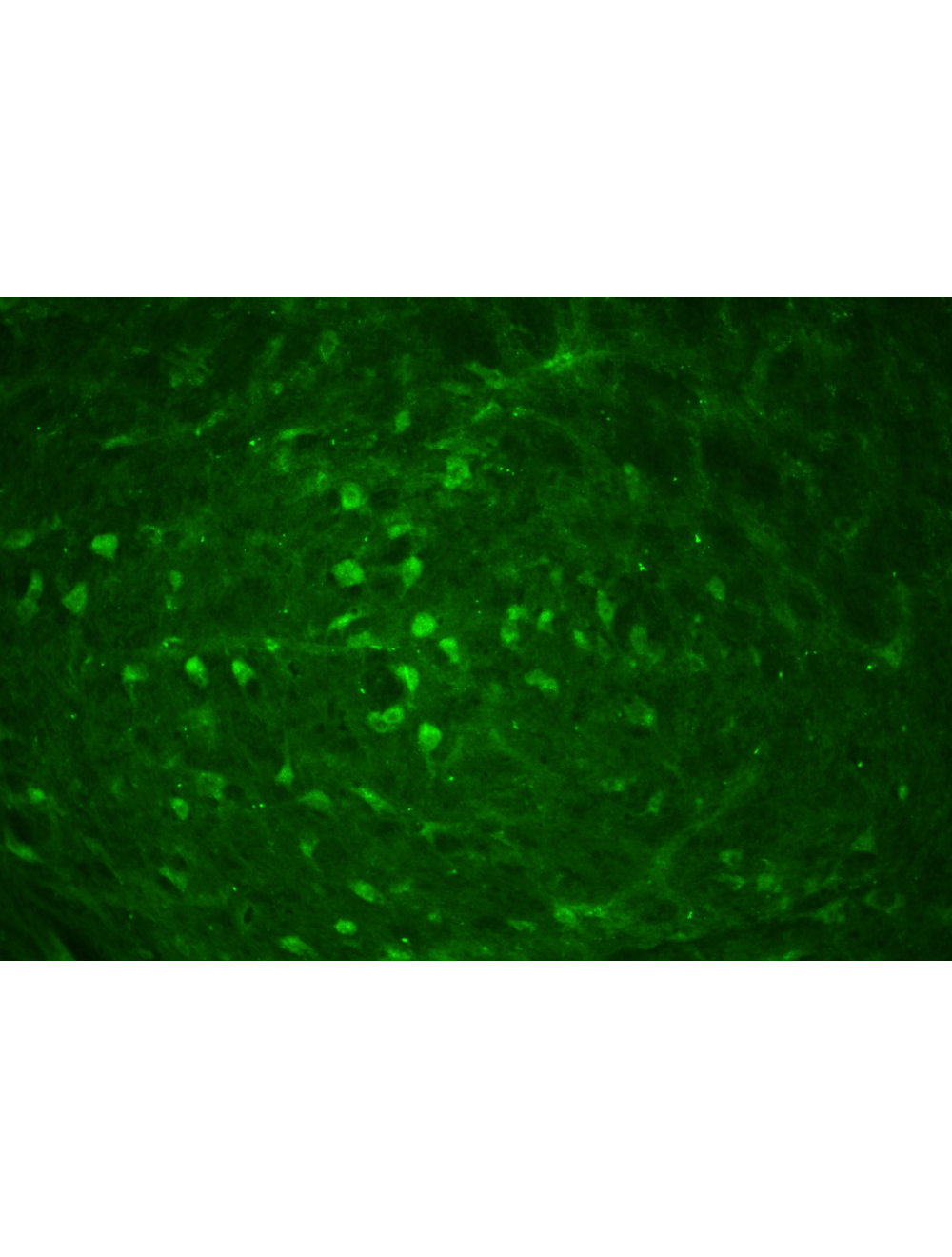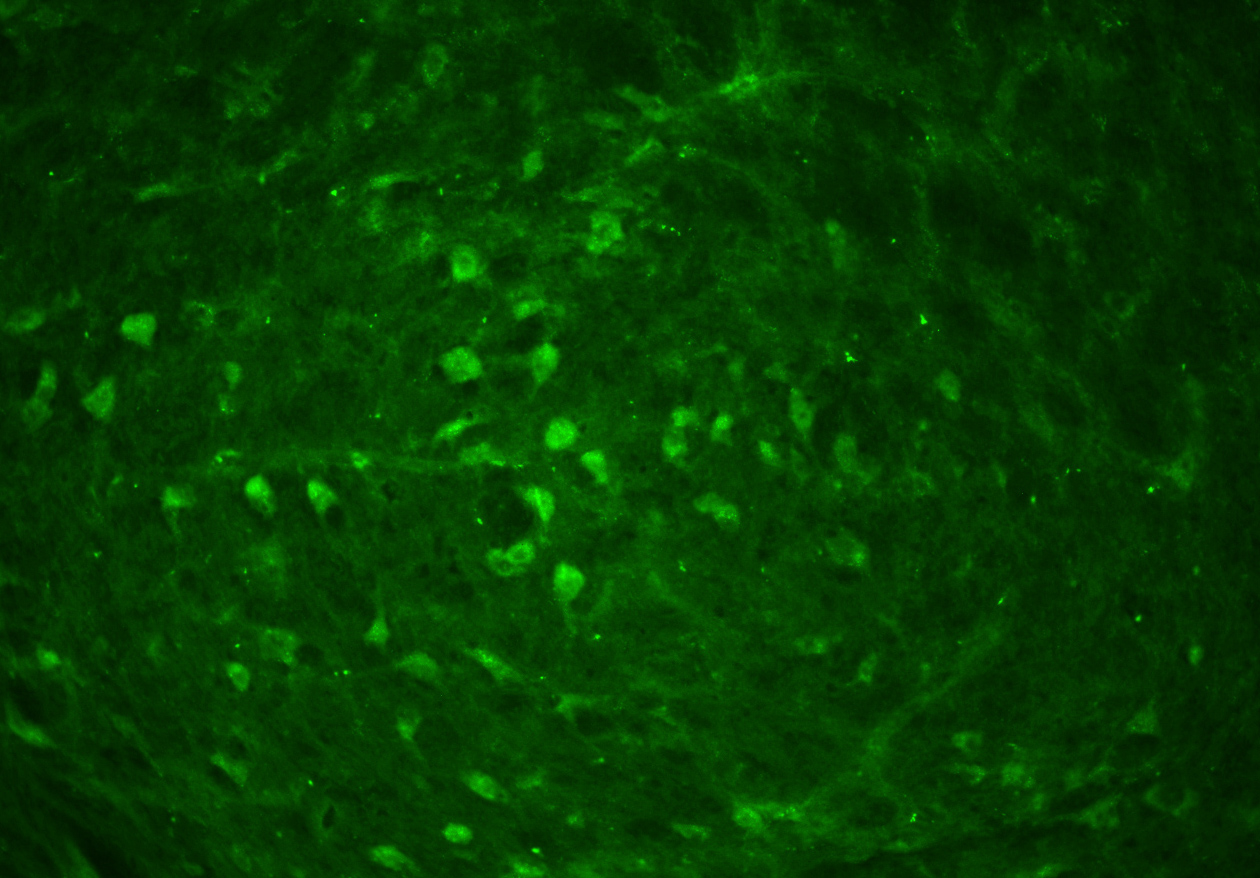Parkinson disease protein 2 (Parkin), Rabbit Polyclonal Antibody
As low as
US$317.00
Only %1 left
Catalog Number
R-114
- Product Name Parkinson disease protein 2 (Parkin), Rabbit Polyclonal Antibody
- Product Description Rabbit anti-Parkinson disease protein 2 (Parkin) Polyclonal Antibody (Unconjugated), suitable for WB, IHC-Frozen.
- Alternative Names Ubiquitin E3 ligase PRKN; Parkinson juvenile disease protein 2; Parkinson disease protein 2; PARK2; PRKN
- Application(s) IHC-Frozen, WB
- Antibody Host Rabbit
- Antibody Type Polyclonal
- Specificity This antiserum is known to be highly specific for Parkin shown by IHC and WB. This antibody is known to react with rat and human Parkin.
- Species Reactivity Human, Rat
- Immunogen Description A synthetic peptide (NSLIKELHHFRILGEEQ) as part of human Parkin conjugated to KLH has been used as the immunogen.
- Conjugate Unconjugated
- Purity Description Whole serum
- Regulatory Status For research use only.
Product Info
- Product Description Rabbit anti-Parkinson disease protein 2 (Parkin) Polyclonal Antibody (Unconjugated), suitable for WB, IHC-Frozen.
- Application(s) IHC-Frozen, WB
- Application Details IHC, WB. A dilution of 1:1000 is recommended for immunohistochemistry and 1:2000 for western blot. Nice staining is achieved in neuronal and cytoplasmic granules sections treated with citrate buffer for antigen retrieval. Few inclusions are stained but these were not positively identified as Lewy bodies. Biosensis recommends optimal dilutions/concentrations should be determined by the end user.
- Target Parkinson disease protein 2 (Parkin)
- Specificity This antiserum is known to be highly specific for Parkin shown by IHC and WB. This antibody is known to react with rat and human Parkin.
- Target Host Species Human
- Species Reactivity Human, Rat
- Antibody Host Rabbit
- Antibody Type Polyclonal
- Antibody Isotype Mixed
- Conjugate Unconjugated
- Immunogen Description A synthetic peptide (NSLIKELHHFRILGEEQ) as part of human Parkin conjugated to KLH has been used as the immunogen.
- Purity Description Whole serum
- Format Lyophilized
- Reconstitution Instructions Spin vial briefly before opening. Reconstitute in 100 µL sterile-filtered, ultrapure water. Centrifuge to remove any insoluble material.
- Storage Instructions After reconstitution keep aliquots at -20°C for a higher stability, and at 2-8°C with an appropriate antibacterial agent. Glycerol (1:1) may be added for an additional stability. Avoid repetitive freeze/thaw cycles.
- Batch Number Please see item label.
- Expiration Date 12 months after date of receipt (unopened vial).
- Alternative Names Ubiquitin E3 ligase PRKN; Parkinson juvenile disease protein 2; Parkinson disease protein 2; PARK2; PRKN
- Uniprot Number O60260
- Uniprot Number/Name O60260 (PRKN_HUMAN)
- Scientific Background FUNCTION: Functions within a multiprotein E3 ubiquitin ligase complex, catalyzing the covalent attachment of ubiquitin moieties onto substrate proteins. These substrates include SYT11, CCNE1, GPR37, STUB1, a 22 kDa O-linked glycosylated isoform of SNCAIP and SEPT5. May play a more general role in the ubiquitin proteasomal pathway by participating in the removal and/or detoxification of abnormally folded or damaged protein. Loss of this ubiquitin ligase activity appears to be the mechanism underlying pathogenesis of PARK2. May protect neurons against alpha synuclein toxicity, proteasomal dysfunction, GPR37 accumulation, and kainate-induced excitotoxicity. May play a role in controlling neurotransmitter trafficking at the presynaptic terminal and in calcium-dependent exocytosis. Regulates cyclin E during neuronal apoptosis. May represent a tumor suppressor gene. SUBCELLULAR LOCATION: Cytoplasm. Co-localizes with STY11 in neutrites. Co-localizes with SNCAIP in brainstem Lewy bodies. TISSUE SPECIFICITY: Highly expressed in the brain including the substantia nigra. Expressed in heart, testis and skeletal muscle. Expression is down-regulated or absent in tumor biopsies, and absent in the brain of PARK2 patients. Overexpression protects dopamine neurons from kainate-mediated apoptosis.
- Shipping Temperature 25°C (ambient)
- UNSPSC CODE 41116161
- Regulatory Status For research use only.
Specifications
-
Specific References
Song Y. J. C. et al (2009). Degeneration in different parkinsonian syndromes relates to astrocyte type and astrocyte protein expression. J. Neuropathol. Exp. Neurol. Oct 2009;68(10):1073-1083
Huang Y. et al (2008). LRRK2 and parkin immunoreactivity in multiple system atrophy inclusions. Acta Neuropathol. 2008 Dec;116(6):639-46.
-
General References
Hottori et al. (1998) Biochem Biophys Res Commun. 249 (3): 754-758
Kitada et al. (1998). Nature. 392: 605-608
Kumru, H., et al., Ann. Neurol. 56(4):599-603 (2004).
Pigullo, S., et al., Parkinsonism Relat. Disord. 10(6):357-362 (2004).
Yao, D., et al., Proc. Natl. Acad. Sci. U.S.A. 101(29):10810-10814 (2004).
West, A.B., et al., J. Biol. Chem. 279(28):28896-28902 (2004).
Wang, F., et al., Genes Chromosomes Cancer 40(2):85-96 (2004).

 1800 605-5127
1800 605-5127 +61 (0)8 8352 7711
+61 (0)8 8352 7711

